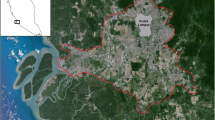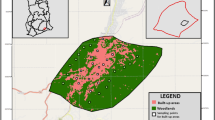Abstract
Urban nature is crucial for the quality of human life both within cities and beyond. In many developed cities, the numbers of restoration-through-revegetation projects have rapidly increased over the decades. However, the extent to which revegetated habitats perform compensatory roles for remnant habitats is poorly understood. We compared butterfly and ground beetle assemblages among three park types (five remnant parks, four newly established parks and five old established parks) and seven built-up sites in Tokyo, central Japan. Butterflies were classified into woodland or open-land and into patch-dependent or matrix-dwelling species. For both taxa, remnant parks and built-up sites had the highest and lowest species richness and abundance, respectively. Although the richness and abundance of open-land and matrix-dwelling butterflies did not differ among the three park types, those of woodland and patch-dependent species were significantly highest in remnant parks. In short, after 50 years, established parks did not attain the same insect assemblages as those in remnant parks. These results illustrate that whist revegetation is an effective and fast-acting conservation measure for generalist species (i.e., widely distributed species), this value is limited for specialists. In highly urbanised landscapes, therefore, even small remnant woodlands provide important refuges for urban wildlife. Remnant protection programs at the early stage of city development would decide the fate of urban biodiversity.


Similar content being viewed by others
References
Bates D, Maechler M, Bolker B (2012) Linear mixed-effects models using S4 classes. http://cran.r-project.org/web/packages/lme4/index.html. Accessed 3 Dec 2012
Beier P, Noss RF (2008) Do habitat corridors provide connectivity? Conserv Biol 12:1241–1252
Borsboom AC, Wang J, Lees N, Mathieson M, Hogan L (2002) Measurement and integration of fauna biodiversity values in Queensland agroforestry systems. Rural Industries Research and Development Corporation
Brown C, Grant M (2005) Biodiversity and human health: what role for nature in healthy urban planning? Built Environ 31:326–338
Croci S, Butet A, Georges A, Aguejdad R, Clergeau P (2008) Small urban woodlots as biodiversity conservation hotspot: a multi-taxon approach. Landsc Ecol 23:1171–1186
Dearborn DC, Kark S (2009) Motivations for conserving urban biodiversity. Conserv Biol 24:432–440
Evans KL, Chamberlain DE, Hatchwell BJ, Gregory RD, Gaston KJ (2011) What makes an urban bird? Glob Change Biol 17:32–44
Fisher J, Lindenmayer DB (2002) The conservation value of paddock trees for birds in a variegated landscape in southern New South Wales. 2. Paddock trees as stepping stones. Biodivers Conserv 11:833–849
Fuller RA, Irvine KN, Devine-Wright P, Warren PH, Gaston KJ (2007) Psychological benefits of green space increase with biodiversity. Biol Lett 3:390–394
Gaston KJ, Warren PH, Thompson K, Smith RM (2005) Urban domestic gardens (IV): the extent of the resource and its associated features. Biodivers Conserv 14:3327–3349
Gill FB (2007) Ornithology. W. H. Freeman & Company, New York
Haynes KJ, Cronin JT (2003) Matrix composition affects the spatial ecology of a prairie planthopper. Ecology 84:2856–2866
Hobbs R, Catling PC, Wombey JC, Clayton M, Atkins L, Reid A (2003) Faunal use of bluegum (Eucalyptus globulus) plantations in southwestern Australia. Agrofor Syst 58:195–212
Kanowski J, Catterall CP, Wardell-Johnson GW (2005) Consequences of broadscale timber plantations for biodiversity in cleared rainforest landscapes of tropical and subtropical Australia. Forest Ecol Manag 208:359–372
Koivula M, Punttila P, Haila Y, Niemelä J (1999) Leaf litter and the small-scale distribution of carabid beetles (Coleoptera, Carabidae) in the boreal forest. Ecography 22:424–435
Magura T, Tóthmérész B, Molnár T (2004) Changes in carabid beetle assemblages along an urbanisation gradient in the city of Debrecen, Hungary. Landsc Ecol 19:747–759
Magura T, Tóthmérész B, Elek Z (2005) Impacts of leaf-litter addition on carabids in a conifer plantation. Biodivers Conserv 14:475–491
Magura T, Tóthmérész B, Molnár T (2008) A species-level comparison of occurrence patterns in carabids along an urbanisation gradient. Landsc Urban Plan 86:134–140
Makino S, Goto H, Inoue T, Sueyoshi M, Okabe K, Hasegawa M, Hamaguchi K, Tanaka H, Okochi I (2006) The monitoring of insects to maintain biodiversity in Ogawa Forest Reserve. Environ Monit Assess 120:477–485
Miller JR (2005) Biodiversity conservation and the extinction of experience. Trends Ecol Evol 20:430–434
Munro NT, Lindenmayer DB, Fischer J (2007) Faunal response to revegetation in agricultural areas of Australia: a review. Ecol Manage Restor 8:199–207
Oksanen J (2011) Ordination methods, diversity analysis and other functions for community and vegetation ecologists. http://cran.r-project.org/web/packages/vegan/index.html. Accessed 3 Dec 2012
Pollard E (1977) A method for assessing changes in the abundance of butterflies. Biol Conserv 12:116–134
Pyšek P, Richardson DM, Pergl J, Jarošík V, Sixtová Z, Weber E (2008) Geographical and taxonomic biases in invasion ecology. Trends Ecol Evol 23:237–244
R Development Core Team (2012) R: a language and environment for statistical computing. R Foundation for Statistical Computing, Vienna
Ricketts TH (2001) The matrix matters: effective isolation in fragmented landscapes. Am Nat 158:87–99
Ries L, Debinski DM (2001) Butterfly responses to habitat edges in the highly fragmented prairies of Central Iowa. J Anim Ecol 70:840–852
Schtickzelle N, Gwénaëlle M, Michel B (2006) Dispersal depression with habitat fragmentation in the bog fritillary butterfly. Ecology 87:1057–1065
Simberloff D, Parker IM, Windle PN (2005) Introduced species policy, management, and future research needs. Front Ecol Environ 3:12–20
Simenstad C, Reed D, Ford M (2006) When is restoration not? Incorporating landscape-scale processes to restore self-sustaining ecosystems in coastal wetland restoration. Ecol Engine 26:27–39
Soga M, Koike S (2012a) Life-history traits affect the vulnerability of butterflies to habitat fragmentation in urban remnant forests. Ecoscience 19:11–20
Soga M, Koike S (2012b) Relative importance of quantity, quality and isolation of patches for butterfly diversity in fragmented urban forests. Ecol Res 27:265–271
Soga M, Koike S (2013) Patch isolation only matters for specialist butterflies but patch area affects both specialist and generalist species. J Forest Res 18:270–278
Soga M, Yamaura Y, Koike S (2013) From ecological pessimism to conservation chance: reviving living dead in changing landscapes. Anim Conserv 16:16–18
Tanaka B (1988) A method of environmental evaluation by means of faunal composition of butterflies. Spec Bull Lepidopterol Soc Jpn 6:527–566
Thompson K, Austin KC, Smith RH, Warren PH, Angold PG, Gaston KJ (2003) Urban domestic gardens (I): putting small-scale plant diversity in context. J Veg Sci 14:71–78
Tikkanen O, Martikainen P, Hyvärinen E, Junninen K, Kouki J (2006) Red-listed forest species of Finland: associations with forest structure, tree species, and decaying wood. Ann Zool Fenn 43:373–383
Tokyo Metropolitan Government Bureau of General Affairs (2013) Statistics of Tokyo. http://www.toukei.metro.tokyo.jp/. Accessed 14 Feb 2013
Tóthmérész B, Máthé I, Balázs E, Magura T (2011) Responses of carabid beetles to urbanization in Transylvania (Romania). Landsc Urban Plan 101:330–337
United Nations (2011) Population Division (UNPD), World Urbanization Prospects: the 2011 Revision Population Database (UNPD, New York, 2011). http://esa.un.org/. Accessed 3 Dec 2012
Vasas V, Magura T, Jordán F, Tóthmérész B (2009) Graph theory in action: evaluating planned highway tracks based on connectivity measures. Landsc Ecol 24:581–586
Wettstein W, Schmid B (1999) Conservation of arthropod diversity in montane wetlands: effect of altitude, habitat quality and habitat fragmentation on butterflies and grasshoppers. J Appl Ecol 36:363–373
Woodcock BA, Vogiatzakis IN, Westbury DB, Lawson CS, Edwards AR, Brook AJ, Harris SJ, Lock KA, Maczey N, Masters G, Brown VK, Mortimer SR (2010) The role of management and landscape context in the restoration of grassland phytophagous beetles. J Appl Ecol 47:366–376
Woodcock BA, Bullock JM, Mortimer SR, Pywell RF (2012) Limiting factors in the restoration of UK grassland beetle assemblages. Biol Conserv 146:136–143
Acknowledgments
Thanks to T. Iida for insect identification and J. Horák, R. Didham, and an anonymous referee for helpful comments on the earlier version of our manuscript. We also thank T. Yoshida for helpful discussions. MS was supported by Japan Society of Promotion of Science (No. 243222), and KJG by EPSRC Grant EP/I002154/1 and NERC Grant NE/J015237/1.
Author information
Authors and Affiliations
Corresponding author
Electronic supplementary material
Below is the link to the electronic supplementary material.
Rights and permissions
About this article
Cite this article
Soga, M., Yamaura, Y., Koike, S. et al. Woodland remnants as an urban wildlife refuge: a cross-taxonomic assessment. Biodivers Conserv 23, 649–659 (2014). https://doi.org/10.1007/s10531-014-0622-9
Received:
Accepted:
Published:
Issue Date:
DOI: https://doi.org/10.1007/s10531-014-0622-9




